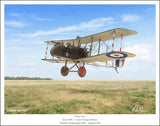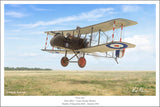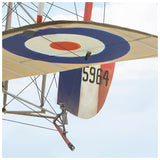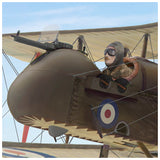First introduced on the Western front in February 1916, the DH.2 was the first effectively armed British single-seat fighter of the Great War. The aircraft was used effectively to counter the Fokker E.III aircraft which had enjoyed air superiority for a period known as the "Fokker Scourge".
With the Fokker E.III, the German Air Force had a machine which was equipped to fire directly through the propeller arc without fear of damaging the propeller because of a newly invented interrupter apparatus which prevented the airplane machine gun from firing if there was a propeller blade in the line of fire.
The British Air Force, lacking such an interrupter apparatus, instead employed a pusher aircraft design with the engine mounted to the rear of the cockpit. This arrangement allowed for a free field of fire for the forward mounted machine gun.
Along with other pusher designs, the DH.2 enjoyed a short period of success eventually being outclassed by the newer German Halberstadt and Albatros fighters entering service.
The machine portrayed here was flown by Lanoe George Hawker, VC, DSO. Hawker distinguished himself flying the RAF B.E.2 aircraft with Number 6 Squadron Royal Flying Corp. He was twice wounded and awarded the Distinguished Service Order for attacking a Zepplin.
Hawker developed various mounting configurations for attachment to an aircraft. Flying a Bristol Scout he eventually downed seven enemy machines making him the first British aerial ace. He was awarded the Victoria Cross.
After some time at home he was made commander of the RFC's first (single seater) fighter squadron - Number 24. It was while in command of this squadron, flying the pictured DH.2 that Major Hawker met his fate in a legendary duel with none other than the Red Baron (Manfred von Richthofen) himself.
Richthofen later wrote he knew he was up against a superb pilot. They circled each other in the air first one way, then the other, trying to gain an advantage on their opponent. The Red Baron's Albatros D.II was a superior machine being faster and more heavily armed than Hawker's DH.2. Nonetheless, Richthofen expended 900 rounds in the duel.
With his fuel running low, Hawker had no choice but to break away from the duel and make a dash for the Allied lines. The Red Baron's guns jammed 50 yards from the lines, however a bullet from his last burst struck Hawker in the back of his head, killing him instantly. German Grenadiers buried Hawker where his machine fell.








